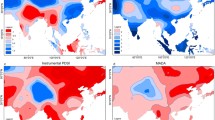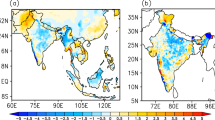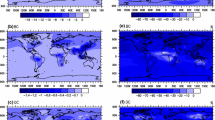Abstract
A series of 60-year numerical experiments starting from 1851 was conducted using a global climate model coupled with an aerosol-cloud-radiation model to investigate the response of the Asian summer monsoon to variations in the secondary organic aerosol (SOA) flux induced by two different estimations of biogenic volatile organic compound (BVOC) emissions. One estimation was obtained from a pre-existing archive and the other was generated by a next-generation model (the Model of Emissions of Gases and Aerosols from Nature, MEGAN). The use of MEGAN resulted in an overall increase of the SOA production through a higher rate of gasto-particle conversion of BVOCs. Consequently, the atmospheric loading of organic carbon (OC) increased due to the contribution of SOA to OC aerosol. The increase of atmospheric OC aerosols was prominent in particular in the Indian subcontinent and Indochina Peninsula (IP) during the pre- and early-monsoon periods because the terrestrial biosphere is the major source of BVOC emissions and the atmospheric aerosol concentration diminishes rapidly with the arrival of monsoon rainfall. As the number of atmospheric OC particles increased, the number concentrations of cloud droplets increased, but their size decreased. These changes represent a combination of aerosol-cloud interactions that were favorable to rainfall suppression. However, the modeled precipitation was slightly enhanced in May over the oceans that surround the Indian subcontinent and IP. Further analysis revealed that a compensating updraft in the surrounding oceans was induced by the thermally-driven downdraft in the IP, which was a result of surface cooling associated with direct OC aerosol radiative forcing, and was able to surpass the aerosolcloud interactions. The co-existence of oceanic ascending motion with the maximum convective available potential energy was also found to be crucial for rainfall formation. Although the model produced statistically significant rainfall changes with locally organized patterns, the suggested pathways should be considered guardedly because in the simulation results, 1) the BVOC-induced aerosol direct effect was marginal; 2) cloud-aerosol interactions were modeldependent; and 3) Asian summer monsoons were biased to a nonnegligible extent.
Similar content being viewed by others
References
Abdul-Razzak, H., and S. J. Ghan, 2000: A parameterization of aerosol activation: 2. Multiple aerosol type. J. Geophys. Res., 105, 6837–6844.
Albrecht, B. A., 1989: Aerosols, cloud microphysics, and fractional cloudiness. Science, 245, 1227–1230.
Berry, E. X., 1967: Cloud droplet growth by collection. J. Atmos. Sci., 24, 688–701.
Bollasina, M. A., Y. Ming, and V. Ramaswamy, 2011: Anthropogenic aerosols and the weakening of the South Asian summer monsoon. Science, 334, 502–505.
Boucher, O., and U. Lohmann, 1995: The sulfate-CCN-cloud albedo effect: A sensitivity study with two general circulation models. Tellus, 47B, 281–300.
Charlson, R. J., J. Langner, H. Rodhe, C. B. Leovy, and S. G. Warren, 1991: Perturbation of the northern hemisphere radiative balance by backscattering from anthropogenic sulfate aerosols. Tellus, 43AB, 152–163.
Chung, S. H., and J. H. Seinfeld, 2002: Global distribution and climate forcing of carbonaceous aerosols. J. Geophys. Res.-Atmos., 107, 4407, doi:10.1029/2001JD001397.
Collins, W. J., R. G. Derwent, C. E. Johnson, and D. S. Stevenson, 2002: The oxidation of organic compounds in the troposphere and their global warming potentials. Climatic Change, 52, 453–479.
Deepak, A., and H. G. Gerber, 1983: Report of the experts meeting on aerosols and their climatic effects, Report of WCP-55, 107 pp., World Meteorological Organization, Geneva, Switzerland.
Dusek, U., and Coauthors, 2006: Size matters more than chemistry for cloud nucleating ability of aerosol particles. Science, 312, 1375–1378.
Engelhart, G. J., A. Asa-Awuku, A. Nenes, and S. N. Pandis, 2008: CCN activity and droplet growth kinetics of fresh and aged monoterpene secondary organic aerosol. Atmos. Chem. Phys., 8, 3937–3949.
Graedel, T. E., and Coauthors, 1993: A compilation of inventories of emissions to the atmosphere. Global Biogeochem. Cycles, 7, 1–26.
Graham, N. E., and T. P. Barnett, 1987: Sea surface temperature, surface wind divergence, and convection over tropical oceans. Science, 238, 657–659.
Guenther, A. B., R. K. Monson, R. Fall, 1991: Isoprene and monoterpene emission rate variability - observations with eucalyptus and emission rate algorithm development. J. Geophys. Res.-Atmos., 96, 10799–10808.
Guenther, A., and Coauthors, 1995: A Global-model of natural volatile organic-compound emissions. J. Geophys. Res., 100, 8873–8892.
Guenther, A., T. Karl, P. Harley, C. Wiedinmyer, P. I. Palmer, and C. Geron, 2006: Estimates of global terrestrial isoprene emissions using MEGAN (Model of Emissions of Gases and Aerosols from Nature). Atmos. Chem. Phys., 6, 3181–3210.
Hallquist, M., and Coauthors, 2009: The formation, properties and impact of secondary organic aerosol: current and emerging issues. Atmos. Chem. Phys., 9, 5155–5235.
Hirabayashi, Y., S. Kanae, I. Struthers, and T. Oki, 2005: A 100-year (1901–2000) global retrospective estimation of the terrestrial water cycle. J. Geophys. Res., 110, D19101, doi:10.1029/2004JD005492.
Huffman, G. J., R. F. Adler, D. T. Bolvin, and G. Gu, 2009: Improving the global precipitation record: GPCP Version 2.1. Geophys. Res. Lett., 36, L17808, doi:10.1029/2009GL040000.
Jacobson, M., 2001: Strong radiative heating due to the mixing state of black carbon in atmospheric aerosols. Nature, 409, 695–697.
Johnson, D. B., 1982: The role of giant and ultragiant aerosol particles in warm rain initiation. J. Atmos. Sci., 39, 448–460.
Jones, A., D. L. Roberts, and A. Slingo, 1994: A climate model study of indirect radiative forcing by anthropogenic sulfate aerosols. Nature, 370, 450–453.
Kanakidou, M., and Coauthors, 2005: Organic aerosol and global climate modeling: A review. Atmos. Chem. Phys., 5, 1053–1123.
Kuhn, U., and Coauthors, 2004: Seasonal differences in isoprene and lightdependent monoterpene emission by Amazonian tree species. Global Change Biol., 10, 663–682.
Lathière, J., C. Hewitt, and D. Beerling, 2010: Sensitivity of isoprene emissions from the terrestrial biosphere to 20th century changes in atmospheric CO2 concentration, climate, and land use. Global Biogeochem. Cycle, 24, GB1004, doi:10.1029/2009GB003548.
Lau, K. M., M. K. Kim, and K. M. Kim, 2006: Asian summer monsoon anomalies induced by aerosol direct forcing: The role of the Tibetan Plateau. Clim. Dynam., 26, 855–864.
Lean, J., G. Rottman, J. Harder, and G. Kopp, 2005: SORCE contributions to new understanding of global change and solar variability. Solar. Phys., 230, 27–53.
Meinshausen, M., and Coauthors, 2011: The RCP greenhouse gas concentrations and their extension from 1765 to 2300. Climatic Change, 9, 213–241.
Menon, S., J. Hansen, L. Nazarenko, and Y. Luo, 2002: Climate effects of black carbon aerosols in China and India. Science, 297, 2250–2253.
Nakajima, T., M. Tsukamoto, Y. Tsushima, A. Numaguti, and T. Kimura, 2000: Modeling of the radiative process in an atmospheric general circulation model. Appl. Opt., 39, 4869–4878.
Pierce, T. E., and P. S. Waldruff, 1991: Pc-Beis - A personal-computer version of the biogenic emissions inventory system. J. Air Waste Manage., 41, 937–941.
Pierce, T., C. Geron, L. Bender, R. Dennis, G. Tonnesen, and A. Guenther, 1998: Influence of increased isoprene emissions on regional ozone modeling. J. Geophys. Res., 103, 25611–25629.
Posselt, R., and U. Lohmann, 2008: Influence of giant CCN on warm rain processes in the ECHAM5 GCM. Atmos. Chem. Phys., 8, 3769–3788.
Quaas, J., and Coauthors, 2009: Aerosol indirect effects - general circulation model intercomparison and evaluation with satellite data. Atmos. Chem. Phys., 9, 8697–8717.
Ramanathan, V., and Coauthors, 2005: Atmospheric brown clouds: Impact on South Asian climate and hydrologic cycle. Proc. Natl. Acad. Sci., 102, 5326–5333.
Ramankutty, N., and J. A. Foley, 1999: Estimating historical changes in global land cover: Croplands from 1700 to 1992. Global Biogeochem. Cycles, 13, 997–1027.
Rosenfeld, D., R. Lahav, A. Khain, and M. Pinsky, 2002: The role of sea spray in cleansing air pollution over ocean via cloud processes. Science, 297, 1667–1670.
Rosenfeld, D., J. Dai, X. Yu, Z. Yao, X. Xu, X. Yang, C. Du., 2007: Inverse relations between amounts of air pollution and orographic precipitation. Science, 315, 1396–1398.
Sanderson, M. G., C. D. Jones, W. J. Collins, C. E. Johnson, and R. G. Derwent, 2003: Effect of climate change on isoprene emissions and surface ozone levels. Geophys. Res. Lett., 30, 1936, doi:10.1029/2003GL017642.
Sato, M., J. E. Hansen, M. P. McCormick, and J. B. Pollack, 1993: Stratospheric aerosol optical depth, 1850–1990. J. Geophys. Res., 98, 22987–22994.
Smith, G. L., and D. Rutan, 1994: Spatial variability of outgoing longwave radiation. J. Atmos. Sci., 51, 1808–1822.
Sudo, K. M. Takahashi J. Kurokawa, and H. Akimoto, 2002: CHASER: A global chemical model of the troposphere 1. Model description. J. Geophys. Res., 107, 4339, doi:10.1029/2001JD001113.
Takahashi, H. G., and T. Yasunari, 2006: A climatological monsoon break in rainfall over Indochina-A singularity in the seasonal march of the Asian summer monsoon. J. Climate, 19, 1545–1556.
Takemura, T., T. Nakajima, O. Dubovik, B. N. Holben, and S. Kinne, 2002: Single-scattering albedo and radiative forcing of various aerosol species with a global three-dimensional model. J. Climate, 15, 333–352.
Takemura, T., T. Nozawa, S. Emori, T. Y. Nakajima, and T. Nakajima, 2005: Simulation of climate response to aerosol direct and indirect effects with aerosol transport-radiation model. J. Geophys. Res., 110, D02202, doi:10.1029/2004JD005029.
Takemura, T., H. Okamoto, Y. Maruyama, A. Numaguti, A. Higurashi, and T. Nakajima, 2000: Global three-dimensional simulation of aerosol optical thickness distribution of various origins. J. Geophys. Res., 105, 17853–17873.
Takemura, T., M. Egashira, K. Matsuzawa, H. Ichijo, R. O’ishi, and A. Abe-Ouchi, 2009: A simulation of the global distribution and radiative forcing of soil dust aerosols at the Last Glacial Maximum. Atmos. Chem. Phys., 9, 3061–3073.
Taylor, K. E., R. J. Stouffer, and G. A. Meehl, 2012: An overview of CMIP5 and the experiment design. Bull. Amer. Meteor. Soc., 93, 485–498.
Tett, S. F. B., P. A. Stott, M. R. Allen, W. J. Ingram, and J. F. B. Mitchell, 1999: Causes of twentieth-century temperature change near the Earth’s surface. Nature, 399, 569–572.
Textor, C., and Coauthors, 2007: The effect of harmonized emissions on aerosol properties in global models - an AeroCom experiment. Atmos. Chem. Phys., 7, 4489–4501.
Tsigaridis, K., and M. Kanakidou, 2007: Secondary organic aerosol importance in the future atmosphere. Atmos. Environ., 41, 4682–4692.
Wang, B., and LinHo, 2002: Rainy season of the Asian-Pacific summer monsoon. J. Climate, 15, 386–398.
Wang, B., Q. Ding, and V. Joseph, 2009: Objective definition of the Indian summer monsoon onset using large scale winds. J. Climate, 22, 3303–3316.
Watanabe, M., and Coauthors, 2010: Improved climate simulation by MIROC5: mean states, variability, and climate sensitivity. J. Climate, 23, 6312–6335.
Yatagai, A. O. Arakawa, K. Kamiguchi, H. Kawamoto, M. I. Nodzu, and A. Hamada, 2009: A 44-year daily gridded precipitation dataset for Asia based on a dense network of rain gauges. Sci. Online Lett. Atmos., 5, 137–140, doi:10.2151/sola.2009-035.
Author information
Authors and Affiliations
Corresponding author
Rights and permissions
About this article
Cite this article
Kim, HJ., Takata, K., Tanaka, K. et al. Regional climatic effects according to different estimations of biogenic volatile organic compounds during the asian summer monsoon. Asia-Pacific J Atmos Sci 50, 423–435 (2014). https://doi.org/10.1007/s13143-014-0033-6
Received:
Accepted:
Published:
Issue Date:
DOI: https://doi.org/10.1007/s13143-014-0033-6




